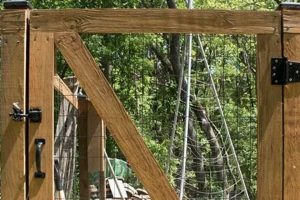The term refers to the design, construction, and installation of window coverings by a homeowner or end-user, rather than purchasing pre-made solutions or hiring a professional. These window coverings are typically louvered panels designed to control light, privacy, and ventilation. An example includes crafting wood panels with adjustable slats to fit a specific window frame.
Such projects offer cost savings, customization options to suit unique architectural styles or personal preferences, and the satisfaction of a hands-on accomplishment. Historically, constructing window coverings in this manner was a necessity, particularly in areas where professionally made products were either unavailable or unaffordable. The practice represents a return to resourcefulness and personalized home improvement.
Understanding the materials, tools, and techniques involved is crucial for successful implementation. Subsequent sections will detail the selection of appropriate wood types, accurate measurement procedures, construction methods, and finishing techniques to achieve durable and aesthetically pleasing results.
Essential Considerations for Self-Made Window Coverings
Successful completion of a self-made window covering project hinges on meticulous planning and execution. The following recommendations can mitigate common pitfalls and enhance the overall quality of the finished product.
Tip 1: Material Selection: Employ hardwoods like poplar or basswood for increased durability and a smoother finish. Avoid softwood alternatives like pine if longevity is paramount, as they are more susceptible to dents and warping.
Tip 2: Precise Measurements: Accurate measurements are non-negotiable. Account for the window frame’s interior dimensions with a precision measuring tool. Erroneous measurements can result in ill-fitting panels, rendering the project unusable.
Tip 3: Louver Angle Consistency: Ensure uniform louver angles throughout the design. This can be achieved by constructing a jig to maintain consistent spacing and angle during assembly. Inconsistent angles detract from the finished product’s aesthetic appeal.
Tip 4: Mortise and Tenon Joinery: Utilize mortise and tenon joinery for robust frame construction. This technique provides superior strength compared to simple butt joints, contributing to the long-term structural integrity of the panels.
Tip 5: Sanding and Preparation: Prior to finishing, thoroughly sand all surfaces with progressively finer grit sandpaper. This removes imperfections and prepares the wood for optimal paint or stain adhesion, resulting in a professional-looking finish.
Tip 6: Hardware Considerations: Select high-quality hinges and mounting hardware designed for window coverings. Inferior hardware can lead to premature failure and compromised functionality, undermining the entire project.
Tip 7: Finishing Application: Apply multiple thin coats of paint or stain, allowing adequate drying time between each coat. This prevents drips and ensures a uniform, durable finish that protects the wood from environmental factors.
Adhering to these guidelines can increase the likelihood of a successful outcome, producing functional and visually appealing window coverings. The subsequent section will address common troubleshooting scenarios encountered during the construction process.
1. Accurate Measurements
Precision in measurement forms the bedrock of any successful self-made window covering project. Deviations from exact dimensions compromise functionality, aesthetics, and structural integrity. The following facets underscore the critical role of accurate measurements.
- Frame Fit and Functionality
Imprecise measurements translate directly to ill-fitting panels within the window frame. Gaps along the edges allow unwanted light penetration, reduce insulation effectiveness, and negate the intended privacy. Shutters that are too large cannot be installed, and those that are too small appear unprofessional and compromise operation.
- Louver Alignment and Operation
Accurate measurements are fundamental for consistent louver spacing and alignment. Variations in panel dimensions affect the uniform tilt and closure of the louvers. Misaligned louvers create uneven light patterns, compromise privacy, and detract from the shutters’ visual appeal.
- Hardware Placement and Secure Mounting
The placement of hinges, latches, and other hardware components hinges on precise dimensional knowledge. Incorrect measurements lead to improperly positioned hardware, resulting in unstable mounting, compromised functionality, and potential damage to the shutters or window frame. Distorted hardware placement directly affects the operation and longevity of the installation.
- Material Utilization and Cost Efficiency
Precise measurements facilitate optimized material usage, minimizing waste and reducing project costs. Incorrect calculations result in over-purchasing materials or cutting components incorrectly, leading to unnecessary expenses and project delays. Optimized material utilization streamlines the construction process.
In essence, accurate measurement is non-negotiable. A commitment to precision from the outset of a window covering project ensures a professional-looking, fully functional, and long-lasting installation. Failure to prioritize accurate measurements undermines every subsequent step in the construction process, resulting in a compromised outcome.
2. Material Selection
The selection of materials is a foundational element in the execution of a window covering project. The chosen material directly impacts the longevity, aesthetic appeal, and functionality of the finished product. In this context, considerations extend beyond mere cost; structural integrity, resistance to environmental factors, and compatibility with desired finishes are paramount. For example, employing a softwood like pine might initially seem economical, but its susceptibility to warping and denting compromises long-term durability, particularly in environments with fluctuating humidity. Conversely, selecting a hardwood such as poplar or basswood provides greater stability and a smoother surface for paint or stain application, resulting in a more refined and enduring outcome.
The choice of material dictates the necessary joinery techniques. Dense hardwoods necessitate robust methods like mortise and tenon joints, ensuring structural integrity under stress. Softer woods may accommodate simpler joinery, but this can sacrifice strength and longevity. Consider the case of mounting hardware: its compatibility with the chosen material is essential. Using screws designed for hardwoods in a softwood panel risks stripping the wood and compromising the secure attachment of the shutter. Conversely, usin
g screws designed for softwoods in a hardwood can lead to breakage.
In summary, material selection for self-made window coverings is a critical decision that influences every subsequent step of the construction process. It is a causal factor, directly impacting durability, aesthetic appeal, and the success of the overall project. Prioritizing material quality and appropriateness ensures a finished product that is both functional and aesthetically pleasing, while also mitigating the need for frequent repairs or replacements. Understanding the interplay between material properties, joinery techniques, and hardware compatibility is crucial for achieving optimal results in this field.
3. Joinery Methods
The structural integrity and longevity of self-constructed window coverings are intrinsically linked to the employed joinery methods. The method chosen dictates the strength, stability, and aesthetic quality of the final product, influencing its resistance to stress and environmental factors.
- Mortise and Tenon Joints
Considered a robust option, the mortise and tenon joint involves fitting a projecting tenon into a precisely cut mortise. This interlocking design provides substantial strength and resistance to racking, crucial for larger panels or those exposed to frequent use. This is often seen with solid wood panel design.
- Dowel Joints
Employing cylindrical dowels inserted into corresponding holes in adjoining pieces, dowel joints offer a balance between strength and ease of execution. Suitable for frame construction and louver attachment, this method provides adequate support while simplifying the assembly process. Dowel joinery are best for light to medium-duty diy shutters, not for heavy material.
- Butt Joints with Reinforcements
The simplest form of joinery, butt joints involve directly attaching two pieces of wood end-to-end. While straightforward to execute, they lack inherent strength and necessitate reinforcement via screws, glue, or metal fasteners. Butt joints reinforced by L-brackets for quick build, but lack of long-term durability.
- Rabbet Joints
These joints are created by cutting a recess along the edge of one piece of wood to receive another. Rabbet joints are typically used for assembling the frame around a panel insert. By having the board slot in, it is more durable than a simple butt joint.
The careful selection and execution of appropriate joinery techniques are vital for ensuring the structural soundness and aesthetic appeal of self-made window coverings. By prioritizing robust joinery, one can create long-lasting and visually appealing panels that enhance any space.
4. Finishing techniques
The application of finishing techniques represents a critical stage in the construction of window coverings. This phase transcends mere aesthetics, directly influencing the long-term durability, resistance to environmental stressors, and overall visual impact of the finished product. In the context of self-made window coverings, the selection and execution of appropriate finishing methods become paramount due to the absence of industrial-scale, factory-applied coatings. For instance, improper sealing can render the wood susceptible to moisture absorption, leading to warping, cracking, and eventual decay. Conversely, a well-executed finish acts as a protective barrier against humidity, sunlight, and physical abrasion, extending the lifespan of the shutters.
Consider the practical implications of various finishing choices. Oil-based paints offer superior penetration and durability, making them suitable for applications where moisture exposure is anticipated, such as in bathrooms or kitchens. However, their extended drying times and higher volatile organic compound (VOC) content necessitate careful ventilation during application. Water-based acrylics, while lower in VOCs and faster drying, may lack the same level of moisture resistance, requiring additional sealant layers. Furthermore, the selection of a compatible primer is essential for optimal paint adhesion and preventing discoloration. A poorly chosen primer can result in paint peeling, bubbling, or uneven coverage, compromising the aesthetic integrity of the window coverings.
In conclusion, the successful application of finishing techniques is integral to realizing the full potential of diy shutters. A thorough understanding of the properties of different finishing materials, coupled with meticulous surface preparation and application techniques, is essential for achieving durable, aesthetically pleasing, and long-lasting results. The final finish is not merely a cosmetic addition, but a protective layer that safeguards the structural integrity of the shutters, ensuring their functionality and visual appeal for years to come. Neglecting this aspect can negate the time and effort invested in the earlier stages of construction.
5. Hardware Installation
The successful functionality of self-made window coverings hinges significantly on the precise and secure installation of hardware components. The choice and placement of hinges, latches, and mounting brackets directly influence operational smoothness, stability, and longevity. Improper hardware installation can negate even the most meticulously constructed shutter panels, resulting in compromised performance and aesthetic degradation.
Consider the hinge selection process. The chosen hinge must be appropriately sized and rated to support the weight of the shutter panel. Under-sized hinges are prone to failure, leading to sagging or detachment. Furthermore, the hinge mortise must be accurately created to ensure proper alignment and prevent binding during operation. Latch mechanisms also require precise installation to ensure secure closure and prevent rattling or misalignment. Incorrectly installed latches compromise privacy and light control, undermining the intended purpose of the window covering. For example, if the hardware is not installed correctly the shutters may swing out of alignment and hit the window.
Accurate hardware installation is not merely a finishing step; it is an integral element of the overall construction process. Prioritizing the selection of high-quality hardware and executing precise installation techniques ensures that self-made window coverings function effectively, maintain their aesthetic appeal, and provide lasting value. Compromising on hardware or installation quality diminishes the investment of time and resources dedicated to panel construction, leading to dissatisfaction and premature failure.
6. Louver Alignment
Louver alignment is a critical factor influencing the performance and aesthetics of self-constructed window coverings. Accurate and consistent alignment directly impacts light control, privacy, ventilation, and the overall visual appeal of diy shutters. Deviations from precise alignment can compromise functionality and diminish the intended de
sign.
- Light Control and Uniformity
Proper louver alignment ensures uniform light distribution when the shutters are partially or fully open. Misaligned louvers create uneven light patterns, resulting in inconsistent illumination within the room. Achieving consistent louver angles and spacing is essential for optimal light control and a harmonious visual effect.
- Privacy and Visibility
Aligned louvers provide consistent privacy by minimizing gaps and ensuring uniform coverage across the window. Misaligned louvers create unintended sightlines, compromising the desired level of privacy. Precise alignment is particularly important in areas where privacy is a primary concern, such as bedrooms or bathrooms.
- Airflow and Ventilation
Consistent louver angles and spacing facilitate controlled airflow through the window covering. Aligned louvers allow for predictable and adjustable ventilation, enabling the user to regulate the amount of fresh air entering the room. Misaligned louvers disrupt the airflow pattern, leading to uneven or restricted ventilation.
- Aesthetic Harmony and Visual Appeal
Uniform louver alignment contributes significantly to the overall aesthetic harmony of self-made window coverings. Consistent angles and spacing create a visually pleasing and professional-looking appearance. Misaligned louvers detract from the shutters’ aesthetic appeal, creating a sense of imperfection and compromising the intended design aesthetic.
In summary, louver alignment is an indispensable element in the successful construction of window coverings. Prioritizing accuracy and consistency in louver alignment ensures optimal light control, privacy, ventilation, and aesthetic appeal, enhancing the overall value and functionality of shutters.
Frequently Asked Questions
This section addresses common queries and misconceptions concerning the design, construction, and installation of self-made window coverings. The information provided aims to clarify crucial aspects and mitigate potential challenges.
Question 1: What is the estimated cost savings associated with self-made versus professionally installed window coverings?
Cost savings vary significantly depending on material choices, window dimensions, and complexity of design. Generally, constructing window coverings can result in a reduction of 30% to 60% compared to professional installation. However, this figure does not account for the time investment required for design, construction, and finishing.
Question 2: What are the primary tools required for constructing window coverings?
Essential tools include a table saw or circular saw for accurate material cutting, a miter saw for precise angle cuts, a drill with various drill bits for hardware installation, a router for creating decorative edges or mortises, a measuring tape, a level, and various hand tools such as screwdrivers and sandpaper. Safety equipment, including eye protection and a dust mask, is mandatory.
Question 3: Which wood types are best suited for crafting durable and aesthetically pleasing window coverings?
Hardwoods such as poplar, basswood, and maple offer superior durability, stability, and finishing characteristics. Softwoods like pine are more susceptible to denting, warping, and uneven finishing. The selection of wood type should consider environmental factors, such as humidity levels, and desired aesthetic outcome.
Question 4: What are the key considerations for accurate measurement of window openings?
Measurements must be precise to ensure proper fit and functionality. Account for the interior dimensions of the window frame, including any irregularities or obstructions. Measure the width and height at multiple points to identify any variations. Consider the desired mounting style (inside or outside the frame) when determining final dimensions.
Question 5: What are the most common pitfalls to avoid during construction?
Common pitfalls include inaccurate measurements, improper material selection, inadequate joinery, uneven finishing, and misaligned hardware installation. Thorough planning, meticulous execution, and adherence to established woodworking principles are crucial for mitigating these challenges.
Question 6: How can one ensure proper louver alignment for optimal light control and privacy?
Consistent louver alignment is achieved through the use of jigs or templates during the construction process. These tools ensure uniform spacing and angle across the entire shutter panel. Careful attention to detail and precise execution are essential for achieving optimal light control and privacy.
In summary, the successful construction of window coverings requires careful planning, attention to detail, and adherence to established woodworking principles. By addressing these common queries and avoiding potential pitfalls, one can achieve functional and aesthetically pleasing results.
The next section provides step-by-step instructions for constructing a basic shutter design.
Conclusion
The foregoing analysis has detailed critical aspects of designing, constructing, and installing window coverings. Material selection, accurate measurement, joinery methods, finishing techniques, hardware installation, and louver alignment represent key determinants of success. Adherence to established woodworking principles and a commitment to precision are paramount.
The information presented serves as a foundation for informed decision-making and skillful execution. The successful implementation of such projects requires diligent planning and a dedication to quality craftsmanship. Future endeavors should prioritize sustainable material sourcing and innovative design solutions to enhance both the functionality and environmental impact of window treatments.







